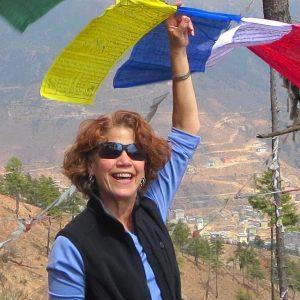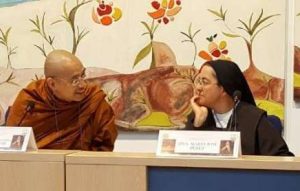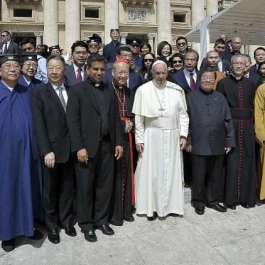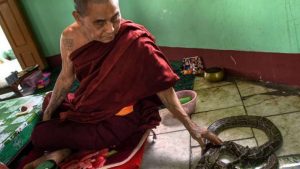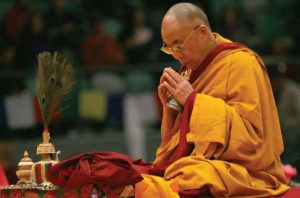Not much activity was to be seen on this hot, humid afternoon in the backroads of Lumbini─save for an occasional languid cow. The endless, bumpy ride via rickshaw over the rocky, rutted dirt road sent my bottom flying five inches off the seat every other second. We turned onto a road lined with countless temples and monasteries in the modern-day town in Nepal where Maya Devi stopped in a bucolic grove some 2,500 years ago to give birth to Siddhartha Gautama. We finally arrived at Thrangu Monastery, also called Canada Monastery. Located in Lumbini’s West Monastic Zone, the outpost was built through the goodwill and support of the Canadian Buddhist community. Residing there is a small cluster of Thrangu nuns and monks who are studying at Lumbini University toward their degrees in Buddhist studies.
The reason for my visit was to meet with three of the Thrangu nuns currently studying there, who were part of a small, select group chosen for a very special task. They were asked to perform a sacred cham dance for the 2014 Kagyu Monlam─a breakthrough moment for the nuns of this lineage, who had never before performed these sacred Vajrayana dances. The Kagyu Monlam is a major international prayer festival held annually in Bodh Gaya, India, presided over by His Holiness the 17th Karmapa, Ogyen Trinley Dorje, head of the Karma Kagyu school of Tibetan Buddhism. With roots dating back to 15th-century Tibet, this great prayer gathering now attracts over 10,000 people in a communal effort to attend Buddhist teachings and pray for peace, harmony, well-being, and happiness for the world. These nuns had accomplished a huge first and I wanted to learn about the noteworthy event.
A year before my visit, I had come across some online videos of the cham dances from this grand event. I homed in on a particular clip of a dakini dance. I was used to seeing these dances performed by monks dressed as dakinis─in silk robes, bone aprons, and crowns─dancing the role of these female wisdom beings, who activate one’s spiritual progress (dakini is translated as khandroma in Tibetan, meaning “sky-goer” or “she who dances through space,” and refers to female emanations of shunyata, or emptiness/spaciousness.) Suddenly, I heard distinctly female voices singing the accompaniment to the dance and I wondered if this was the groundbreaking moment that I thought it might be. As I scrolled down the page on my computer, I noticed the caption below the video: “An Historical First: Nuns Perform in Tsechu Lama dance.” The description identified the nunneries involved, so I set to work arranging to visit them. Now, a year later, here I was sitting opposite these Dharma heroines in their monastery office.
I learned that the cohort of four dancers from Thrangu Tara Abbey was currently split between two locations. Three were in Lumbini at the university pursuing higher studies and one was at the main abbey in Kathmandu. I decided to visit both locations. The nuns all contributed energetically to recounting the details of their story.
The congenial and confident university students─Pasang Drolma Lama, Karma Drolma Gurung, and Jamyang Lhamo─were originally from Nubri and Manang in the high Himalayan region of Nepal, having joined Thrangu Abbey at ages 13, 14, and 15 respectively. Now in their mid-30s, they are boundary-breakers in more ways than one. They confirmed my hunch that no one in their home villages had a university degree when they were growing up.


A week later in Kathmandu, I met the fourth dancer, Sherab Sangmo, along with Chokyi Lamo, a nun who did not dance at the Kagyu Monlam, but had participated in other Thrangu dance activities and was a very capable spokesperson. She recalled how Thrangu Nunnery had received a letter from the Karmapa’s office requesting that four nuns perform a cham for the Monlam. Eight more nuns from Keku Dagmo Choling Nunnery in Sikkim would also perform together with them. Because Kagyu nuns had never performed the cham dances prior to the 2014 Monlam, the Thrangu nuns understood the Karmapa’s special request to be part of his efforts to forward gender equality. His Holiness had previously opened the position of umdze (chantmaster) and the activity of debate to female practitioners, so this seemed to follow the pattern. In fact, when I checked with Khenpo Karma Tenkyong, a spokesperson from the Karmapa’s office, he confirmed that indeed, this was His Holiness’ motivation and added that the aspiration was that cham performance would be an ongoing practice for female practitioners.

The nuns were asked to perform the Kadrinchenma Cham and sing the accompanying liturgy. As the cham dances had always been performed by monks, the nuns would have to learn the dance and prayer from monk cham masters (champon). The four nuns from Thrangu and eight nuns from Keku Dagmo Choling traveled to Palchen Choling Monastery in Sikkim to train with the monks for 20 days, learning the cham and its prayer. After this initial period of training, the nuns were assigned their specific roles─four would sing and eight would dance.
I asked the Thrangu group why they were chosen from all the nuns at the abbey to participate in this exceptional experience. They responded that they had been performing a dance of the Twenty-One Praises of Tara and were known to be confident dancers at ease with performing in public. I perked up at this and asked, “Who created this Tara dance? I too dance the Twenty-One Praises of Tara.” Determined to get to the bottom of this quickly, I stood at the end of the conference table and performed the opening section singing my own accompaniment. Just as I was about to dance the mantra refrain “Om Tare Tutarre Ture Soha,” one of the nuns shouted out, “Om Tare” with the same gleeful inflection that Prema Dasara, the creator of the dance, vocalizes when leading the dance. The entire group burst into laughter as we all realized that we shared this dance practice in common. The Thrangu nuns have performed this Tara dance for many important occasions at their abbey as well as abroad. Sadly, the 2015 earthquake put a stop to the practice.


Pasang Drolma admitted to feeling nervous at the immense prospect of performing at the Monlam. But the nuns’ confidence was bolstered in advance of the event with two opportunities to demonstrate their proficiency: once, they had performed for Thrangu Rinpoche and another time, they had performed for the Karmapa and all the monk performers during the chamjug (formal dance rehearsal). After the chamjug, the Karmapa gave the nuns his blessing and the empowerment to practice the cham. Pasang Drolma recalled that His Holiness did not just give them the usual blessing by bestowing a kata (white ceremonial scarf), but instead gave them a hand blessing by placing his hands directly on their heads─an exceedingly meaningful gesture.
Kadrinchenma is performed by the dakinis in two separate episodes during the larger Tsechu Cham—a full program of sacred cham in honor of Padmasambhava (Guru Rinpoche), the tantric master who brought Buddhism from India to the Himalayan region in the mid-eighth century. All the nuns were quick to echo the Karmapa’s teaching on how the Tsechu Cham came into the Kagyu repertoire. Tsechu means “10th day” and refers to Padmasambhava’s departing promise to his followers. As Guru Rinpoche was leaving Tibet to bring the Buddhist teachings to the country of rakshas (thought to be Sri Lanka), he vowed to return on the 10th day of each lunar calendar month to dispel the suffering of the people. Hence, tsechu is celebrated throughout the Himalayan region, drawing huge public attendance to view the sacred cham and receive the blessings they convey.
Kadrinchenma literally means “great gratitude,” and the cham is a supplication to Padmasambhava for blessings. The dance is first performed during the Tsechu Cham just after the grand procession of Guru Padmasambhava and his entourage. Once they have completed their circumambulation of the courtyard and are seated, eight dancers dressed as dakinis form a semicircle facing the great Guru. Over their silk brocade robes, they wear elaborate bone ornaments─belt, apron, necklaces, bracelets, earrings─and a five-lobed crown. These accessories signify the dakinis’ embodiment of the six paramitas, or perfections: the necklace represents generosity; armlets and bracelets are morality; earrings indicate patience; head ornaments signify joyful effort; belt and apron illustrate concentration; and the female practitioner’s body represents wisdom. They dance with a damaru (small, hand-held drum representing compassion) in their right hand. The drum is decorated with streamers in the five colors (blue, gold, red, green, and white) symbolizing the five elements. In their left hand, they hold a drilbu (bell, signifying emptiness). Throughout the choreography, they sound the two instruments to animate these two qualities that give rise to enlightened awareness.


Moving with serene control, the dancers slowly pivot on one leg while the other is lifted, and then step to balance as they lift the other leg─all while rattling their hand implements. Each verse ends as they incline their torsos forward, draping the colored streamers across both uplifted hands as they take three steps backward in a reverent gesture of offering. The subtle yet expressive movements performed to the umdzes’ haunting chant is a sublime expression.

The second performance of the cham takes place at the end of the Tsechu Cham, following the final procession, once everyone else has exited. The dakinis face the temple and dance this final entreaty for lasting blessings until, one-by-one or two-by-two, they peel off to exit into the temple dissolving the dance into emptiness.
The Tsechu Cham is a terma or “treasure” revealed by the great 13th century terton (treasure revealer) Guru Chokyi Wangchuk, popularly known as Guru Chowang (1212–70). Terma are understood to be teachings of Padmasambhava hidden either by himself or his foremost disciple Yeshe Tsogyel throughout the Himalayan landscape. They may take the form of scriptures, artifacts, relics, or may appear as visions or dreams directly in the mind-stream of chosen treasure revealers to be rediscovered in the future─when the people and the times would require spiritual fortification.
The extensive Tsechu Cham is a central feature of the Lama Sangdu terma─a worship and practice of Padmasambhava performed during the Tsechu. An oral tradition speaks of Guru Chowang’s visionary visit to Padmasambhava’s Copper-Colored Mountain Paradise (Zangdok Palri), where he saw dakas and dakinis performing a dance. When he awoke, he recorded the dance movements from his vision and arranged the choreography and the chanted liturgy for the Tsechu Cham. Many treasure dances (tercham) have been revealed in this manner.
The practice of Tsechu and the associated cham dances were originally a Nyingma tradition (the oldest of the four main schools of Tibetan Buddhism). According to the Karmapa’s sources, this current practice came to the Karma Kagyu lineage through the Eighth Tai Situpa, Chokyi Jungne (1700–74), who learned the dance through his close ties with the Nyingmapa monastery of Bentsang in Netong. He then instituted the dance at his own seat at Palpung Monastery in eastern Tibet. Later, due to the historically close relationship between the Karmapa and Tai Situ incarnations, the 14th Karmapa Tekchok Dorje (1798–1868) established this cham at his monastic seat at Tsurphu Monastery. The ritual dance practice was maintained as part of Tsurphu’s tradition until 1959, when the 16th Karmapa Rangjung Rigpe Dorje (1924–81) escaped to India and brought the dance with him. He instituted the Tsechu Cham at his seat in exile Rumtek Monastery in Sikkim. Today the practice is thriving at Rumtek and Tsurphu as well as other Nyingma and Kagyu monasteries.
Pasang Drolma reported that the Karmapa was very happy with the nuns’ performance. As he removed their dakini crowns afterward, he asked them if they felt tired and handed them tissues to wipe the sweat from their faces. His Holiness certainly understood the energy involved as he was performing three major cham for the event as well.
As His Holiness and the nuns made history and reinforced the Tsechu Cham tradition with the introduction of female performers, the Karmapa underscored the importance of the cham’s origins and meaning with an earnest teaching to the attendees. Thrangu nun Sherab Sangmo shared her takeaways from the Karmapa’s teaching: “The cham dancer empties herself of ordinary identity and transforms her body, speech, and mind into an expression of the deity’s divine activities. Through her cham performance, she conveys that experience to the viewers thereby purifying and liberating them through seeing the dance.” In this way, the cham dances are a display of “emptiness”—the infinite potential for becoming through our endless and changing interconnections and relationships.
Sherab Sangmo summed up the experience concluding: “Cham is a key to understanding emptiness.” Indeed, with such an extraordinary benefit, my hope is that the Thrangu nuns will find continued opportunities to perform and give us a frequent and clear view of this liberative expression.
Related features from BDG
Through the Eye of a Needle to Dance with the Dakini: Journey to Druk Zangri Khamar
The Chöd Cham of Nagi Gompa: An Alchemy of Radical Courage and Compassion
Dancing to Enlightenment: Drukpa Nuns Bring New Energy to the Songs of Realization
To Dance the Deity Is to Know Her






